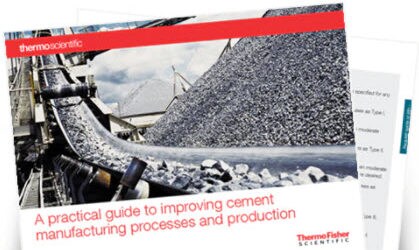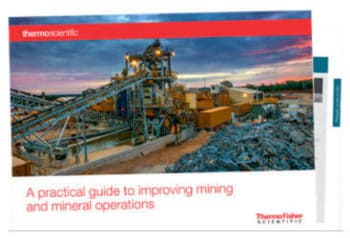Portland cement is the most common type of cement in the world. It is used primarily to make concrete, mortar, and grout. Portland cement manufacturing begins with mining and then grinding raw materials that include limestone and clay, to a fine powder, called raw meal, which is then heated to a sintering temperature as high as 1450 °C in a cement kiln. In this process, the chemical bonds of the raw materials are broken down and then are recombined into new compounds. The resulting clinker (rounded nodules between 1mm and 25mm across) is ground to a fine powder in a cement mill and mixed with gypsum to create cement. The powdered cement is then mixed with water and aggregates to form concrete that is used in construction.
Clinker quality depends on raw material composition. If the raw materials are inappropriate, or if they are blended improperly, buildings and roads made from the concrete will have poor strength and durability. Recent examples can be found in countries such as China and Qatar where construction projects were suspended when it was discovered that low-quality concrete made from a faulty mix was being used.
Because consistent clinker quality is so critically important in making high-performance concrete to avoid devastating building failures, cement manufacturers are investing in new technology to improve the process. A recent article in Cement International (verlagbt.de) described how a cement company sought to stabilize the quality of their raw meal to regulate clinker quality.
Stabilizing the Quality of Raw Meal to Regulate Clinker Quality
The company believed that by implementing the use of high frequency, online analysis and automated control they could produce a more homogenous and stable raw meal. By reducing variability in the raw material chemistry and keeping that chemistry “on target” in appropriate ratios, the quality of cement produced remains high and consistent. The company’s goal was to decrease the standard deviation in the variability of their raw meal by 40% using the quality factor called “Lime Saturation Factor” as their benchmark. To accomplish their goal, the company installed two new analyzer systems: a laboratory X-Ray Flouresence (XRF) system and an online Prompt Gamma Neutron Activation Analysis (PGNAA) system.
The customer uses three raw materials: limestone, clay, and marl in their pre-blending process. The raw materials are crushed separately and are manually sampled every two hours. The samples are analyzed by the XRF system and appropriate pre-mix proportions are calculated to achieve the pre-mix quality target. The three raw materials are then fed into the pre-blending pile. The pre-blended material is then reclaimed and placed into one of three raw material bins prior to the raw mill. High grade limestone and iron ore are, respectively, in the other two bins. Limestone is used to adjust the lime saturation factor (LSF), and iron ore to adjust both the silica modulus (SM) and alumina modulus (AM). An automatic sampler after the mill takes samples of the raw meal every hour, and then transfers the samples to the laboratory via a duct system. Prior to the installation of the online analyzer, the samples were analyzed in the laboratory, the mix ratios then calculated and adjustments made to the raw mix all in a manual process. The time delay for sample preparation and analysis coupled with the potential for sample error made it difficult to optimize control as the raw materials changed.
Improving the Process
To improve upon the process and control system, the plant installed a Prompt Gamma Neutron Activation Analysis (PGNAA)-based crossbelt online elemental analyzer in conjunction with automatic raw material blending software after the corrective bins but before the raw mill. Being that PGNAA is an entirely penetrating analysis technology, the online analyzer provides minute-by-minute analysis results of the entire material stream, not just a surface analysis. The high frequency analysis results are transferred to the automated blending software every minute where new mixing ratios are calculated. The software is integrated with the control system and weigh feeder set points are adjusted automatically every minute. The existing automated sample system is now used simply as a secondary check to periodically ensure the online analyzer remains calibrated with the laboratory X-Ray system.
With the new system in place, this company realized significant improvements in their quality process. They decreased the hourly standard deviation of their Lime Saturation Factor by 70%, decreased the standard deviation of their silica modulus by 50%, and decreased the standard deviation of their alumina modulus by 33%, all while maintaining target chemistry. The culmination of these improvements translates to better clinker quality, lower fuel costs, and more efficient operations overall.
How would you increase your clinker quality? Comment below.








Leave a Reply